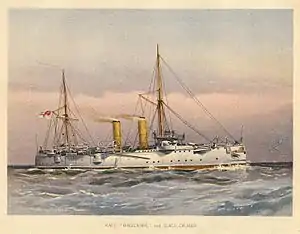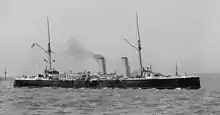Marathon-class cruiser
The Marathon-class cruiser was a class of second class cruiser of the Royal Navy ordered under the naval programme of 1887. The class was a smaller version of the Mersey class.
 Chromolithograph of HMS Magicienne by W. Fred Mitchell, 1892 | |
| Class overview | |
|---|---|
| Name | Marathon class |
| Builders | |
| Operators | |
| Built | 1887–1889 |
| In commission | 1889–1920 |
| Completed | 5 |
| Retired | 5 |
| General characteristics | |
| Type | 2nd class cruiser |
| Displacement |
|
| Propulsion | Dürr boilers (Medusa)[1] |
| Speed | 20 knots (37 km/h; 23 mph) |
| Complement | 218 |
| Armament |
|
Three of the ships, Melpomene, Magicienne and Marathon, were built for foreign (tropical) service, with a sheath of wood and copper - this added weight and made them slightly slower.
Ships
| Name | Builder | Laid down | Launched | Completed |
|---|---|---|---|---|
| HMS Marathon | Fairfields, Govan | 10 August 1887 | 23 August 1888 | 1889 |
| HMS Magicienne | Fairfields, Govan | 10 August 1887 | 12 May 1888 | 1889 |
| HMS Medea | Chatham | 25 April 1887 | 9 June 1888 | 1889 |
| HMS Melpomene | Portsmouth | 10 October 1887 | 20 September 1888 | 1890 |
| HMS Medusa | Chatham | 25 August 1887 | 11 August 1888 | 1889 |

HMS Magicienne (picture taken between 1890 and 1899).
Boiler trials
By 1901, the Royal Navy had ordered eight Dürr boilers from Germany, to be installed as a trial on board Medusa as a substitute for the Belleville boilers then in naval use.[2]
Notes
- Brown, D.K. (2010) [1997]. Warrior to Dreadnought. Seaforth. p. 165. ISBN 978-1-84832-086-4.
- William Allan MP (22 April 1901). "Dürr water-tube boilers". Parliamentary Debates (Hansard). Vol. 92. House of Commons. col. 907.
Eight water-tube boilers of the Durr type have been ordered from Germany. The total cost of the boilers is £19,450. This is exclusive of spare parts and fitting on board. The boilers are to be placed on board H.M.S. "Medusa." They have been guaranteed by the maker to give 155,000 lbs. dry steam per hour from feed water at 80 deg. F., with an air pressure of 1½ inches; 104,000 lbs. per hour with ½ inch air pressure (that used for continuous steaming); and 80,000 lbs. per hour with natural draught.
References
- Colledge, J. J.; Warlow, Ben (2006) [1969]. Ships of the Royal Navy: The Complete Record of all Fighting Ships of the Royal Navy (Rev. ed.). London: Chatham Publishing. ISBN 978-1-86176-281-8.
- Friedman, Norman (1912). British Cruisers of the Victorian Era. Seaforth Publishing. ISBN 978-1-84832-099-4.
- Winfield, Rif (1904). The Sail and Steam Navy List: All the Ships of the Royal Navy 1815-1889. Chatham Publishing. ISBN 1-86176-032-9.
External links
Wikimedia Commons has media related to Marathon class cruiser.
This article is issued from Wikipedia. The text is licensed under Creative Commons - Attribution - Sharealike. Additional terms may apply for the media files.